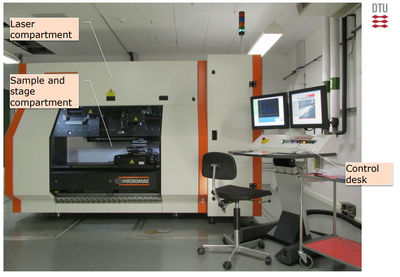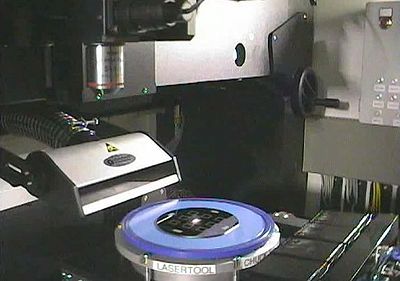Specific Process Knowledge/Back-end processing/Laser Micromachining Tool
Feedback to this page: click here
Unless anything else is stated, everything on this page, text and pictures are made by DTU Nanolab.
All links to Kemibrug (SDS) and Labmanager Including APV and QC requires login.
Laser Micromachining Tool
The Laser Micromachining Tool is a microSTRUCT vario from the company 3D-Micromac AG.
The machine is located in the basement of building 346 under the cleanroom.
The user manual(s), user APV(s), technical information and contact information can be found in LabManager: [1]
It is equipped with 2 high power lasers :
- a 50W picosecond laser that can emit light at 3 wavelengths: 355nm, 532nm and 1064nm (Time-Bandwidth Products, Fuego/Duetto. See some details in this article: [2] ) with a pulse repetition rate from 200kHz up to 8000kHz.
- and a
- a 100W nanosecond laser with a wavelength of 1064nm (IPG Laser YLP-HP series) with a pulse repetition rate of 100kHz (currently out of use).
The system is able to produce micro structures in different kinds of materials like metals, ceramics, composite materials, etc. It can produce features down to ~10µm size over a large area. It can scan over an area of up to ~15x15cm without moving the sample. By moving the sample on the large x-y-stage this area can be extended by stitching.
The laser can use Autocad DXF files for the pattern design. To create these files we recommend to use Clewin 5. See more info here.
Technical specifications
Performances
| Purpose | Patterning, milling and dicing substrates | Mainly for patterning, milling, drilling with high aspect ratio and dicing substrate with micrometric shapes and above (> 10µm) | ||||
|---|---|---|---|---|---|---|
| Performances | Resolution |
Down to 10µm with the blue laser (355nm). Depending on the depth wished. | ||||
| Maximum writing area |
Depends of the optics. Max size :
| |||||
| Max. output power @100%(laser TB width – picosecond) |
| |||||
| Output power@100%(laser IPG – nanosecond) |
Repetition rate : 10kHz to 100kHz (Currently non-available)
| |||||
| Substrates | Material allowed |
| ||||
| Material NOT allowed |
| |||||
| Parameters | Characteristics |
|
Process information
Result from the acceptance test
Results from default process 
Laser Processing parameters
The following parameters provide information about the necessary values for machining different materials. However, most parameters can be further optimized in order to reduce the amount of debris and/or reduce the process time.
| Material | Optics | Frequency | Intensity | Power measured @10% | Writing speed | Number of burst | Number of Z-offset | Number of iteration | Number of parallel lines | Gap in between line | Parameter file | Comments |
| Silicon 525µm | Green(532nm/255mm) | 200 kHz | 100% | 0,57 W | 50 mm/s | 1 burst | none | 4 | 1 | N/A | Silicon dicing green parameters | Easily break silicon in cristal plan. Depth of the groove : 25µm |
| Silicon (525µm) + Si3N4 (150nm up to 1,2µm) OR SiO2 (150nm up to 320nm) | Red (1064nm/255mm) | 200 kHz | 100% | 2,8 W | 1000 mm/s | 3 bursts | 1 (-0,3mm) | 350/100 | 4 | 50 µm | Silicon nitride cutting parameters | Samples can easily be removed with a soft mechanical pressure. A layer of resist can be deposited on the top without influenced the dicing. Thicker layers (oxyde or nitride) have not been tested. |
| Nickel (320µm) | Green(532nm/255mm) | 200 kHz | 100% | 0,64 W | 300 mm/s | 3 burst | none | 4320 | 1 | N/A | Cutting Ni 320µm parameters | Cutting through only blue tape left |
| Pyrex (1000µm) | Red(1064nm/255mm) | 200 kHz | 100% | 2,8 W | 1000 mm/s | 1 burst | none | 99 | 13 | 20 µm | Cutting Pyrex 1000µm for microfluidic hole parameters | Increase/decrease the number of iteration to increase/decrease the width of the hole. Microscope view of the chanel |
| Pyrex/Borosilicate glass (525µm) | Red(1064nm/255mm) | 200 kHz | 100% | 2,96 W | 1000 mm/s | 1 burst | 4 (-0,1/-0,2/-0,3/-0,4mm) | 300/500/700/900/1200 | 4 | 20 µm | Cutting Pyrex 525µm parameters | Cutting through. Dicing circle. Can probably be optimized: 3 lines may be enough and half the iterations (tried by Azeem) |
| Steel (50µm) | Green(532nm/255mm) | 200 kHz | 20% | 0,55 W | 500 mm/s | 1 burst | 0 | 22 | Cutting steel 50µm | Cutting shrim for Injection molder. | ||
| Steel (100µm) | Green(532nm/255mm) | 200 kHz | 25% | 0,55 W | 500 mm/s | 1 burst | 0 | 35 | Cutting steel 100µm | Cutting shrim for Injection molder. | ||
| Steel (200µm) | Green(532nm/255mm) | 200 kHz | 25% | 0,55 W | 500 mm/s | 1 burst | 0 | 72 | Cutting steel 200µm | Cutting shrim for Injection molder. | ||
| Aluminum (400µm) | Green(532nm/255mm) | 200 kHz | 100% | ?? W | 100 mm/s | 3 bursts | 0 | 35-40 | 4 | 20 | cutting Al 400µm | Cutting shadowmask for Wordentec. |
| Aluminum (600µm) | Red IPG(1064nm/255mm) | 100 kHz | 100% | - W | 1000 mm/s | 1 bursts | 0 | 110 | 4 | 40 | cutting Al 600µm | Shadowmask. |
The parameter filename extension is here set to .xls because of MediaWiki restrictions. The 3DMM laser software uses .par as parameter file extension. The file should be a pure text-file with no formatting codes etc.

